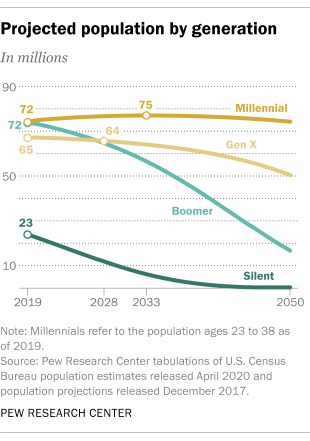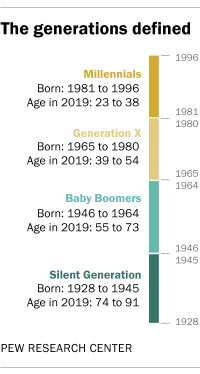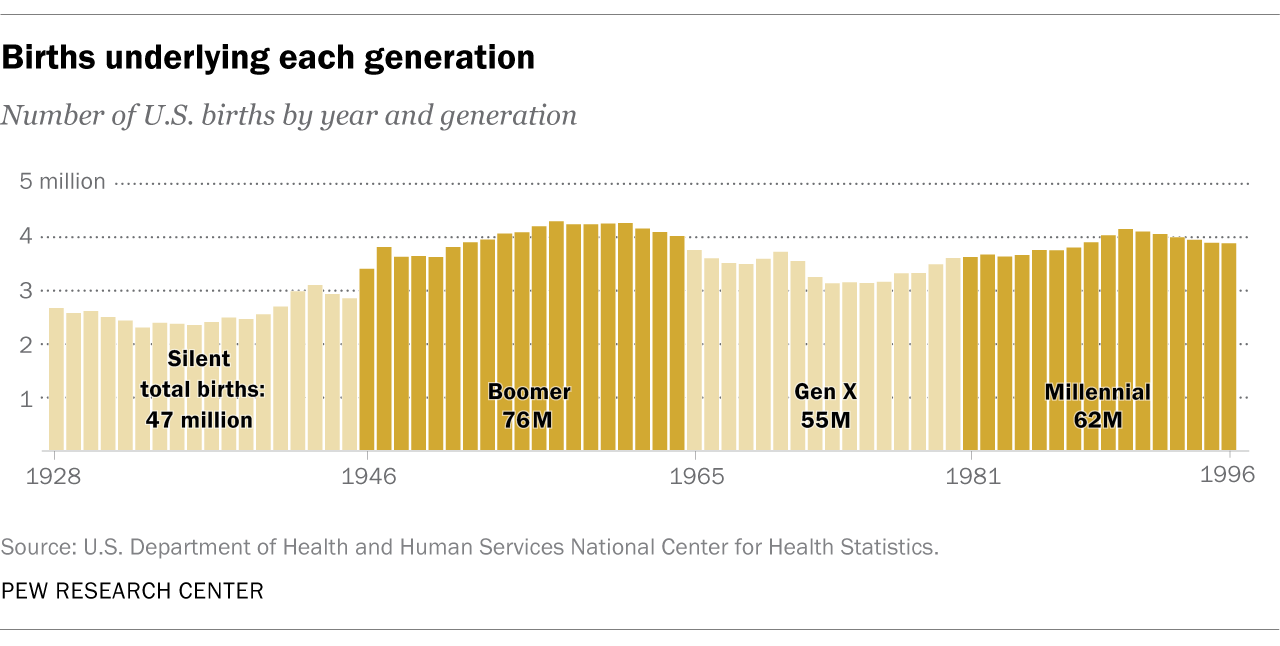Our approach to generational analysis has evolved to incorporate new considerations. Learn more about how we currently report on generations, and read tips for consuming generations research.

Millennials have surpassed Baby Boomers as the nation’s largest living adult generation, according to population estimates from the U.S. Census Bureau. As of July 1, 2019 (the latest date for which population estimates are available), Millennials, whom we define as ages 23 to 38 in 2019, numbered 72.1 million, and Boomers (ages 55 to 73) numbered 71.6 million. Generation X (ages 39 to 54) numbered 65.2 million and is projected to pass the Boomers in population by 2028.
The Millennial generation continues to grow as young immigrants expand its ranks. Boomers – whose generation was defined by the boom in U.S. births following World War II – are aging and their numbers shrinking in size as the number of deaths among them exceeds the number of older immigrants arriving in the country.
How we did this
Population figures for 2019 and earlier years are based on Census Bureau population estimates (2019 vintage and available by single year of age). Population sizes for 2020 to 2050 are based on Census Bureau population projections released in 2017 (and also available by single year of age). Live births by year are published by the National Vital Statistics System of the National Center for Health Statistics.
This post was originally published on Jan. 16, 2015, under the title “This year, Millennials will overtake Baby Boomers.” It was updated April 25, 2016, to reflect the changing population, under the headline “Millennials overtake Baby Boomers as America’s largest generation” This reflected the Center’s definition of Millennials at the time (born between 1981 and 1997).
A third revision published March 1, 2018, reflected the Center’s newly revised definition, under which Millennial births end in 1996. Under that new definition, the Millennial population was smaller than that of Boomers, resulting in the headline “Millennials projected to overtake Baby Boomers as America’s largest generation.”
This latest revision reflects the newly available July 1, 2019, population estimates released in April 2020, as well as new Census Bureau population projections released in 2017. Under these estimates, Millennials have overtaken Boomers under the Center’s revised definition.

Because generations are analytical constructs, it takes time for popular and expert consensus to develop as to the precise boundaries that demarcate one generation from another. In early 2018, Pew Research Center assessed demographic, labor market, attitudinal and behavioral measures to establish an endpoint – albeit inexact – for the Millennial generation. Under this updated definition, the youngest “Millennial” was born in 1996.
Here’s a look at some generational projections.
Millennials
- With immigration adding more numbers to this group than any other, the Millennial population is projected to peak in 2033, at 74.9 million. Thereafter, the oldest Millennial will be at least 52 years of age and mortality is projected to outweigh net immigration. By 2050 there will be a projected 72.2 million Millennials.

Generation X
- For a few more years, Gen Xers are projected to remain the “middle child” of generations – caught between two larger generations, the Millennials and the Boomers. Gen Xers were born during a period when Americans were having fewer children than in later decades. When Gen Xers were born, births averaged around 3.4 million per year, compared with the 3.9 million annual rate from 1981 to 1996 when the Millennials were born.
- Gen Xers are projected to outnumber Boomers in 2028, when there will be 63.9 million Gen Xers and 62.9 million Boomers. The Census Bureau estimates that the Gen X population peaked at 65.6 million in 2015.
Baby Boomers
- Baby Boomers have always had an outsize presence compared with other generations. They peaked at 78.8 million in 1999 and remained the largest living adult generation until 2019.
- By midcentury, the Boomer population is projected to dwindle to 16.2 million.
Note: This is an update of a post originally published on Jan. 16, 2015. See the “How we did this” box for details.
